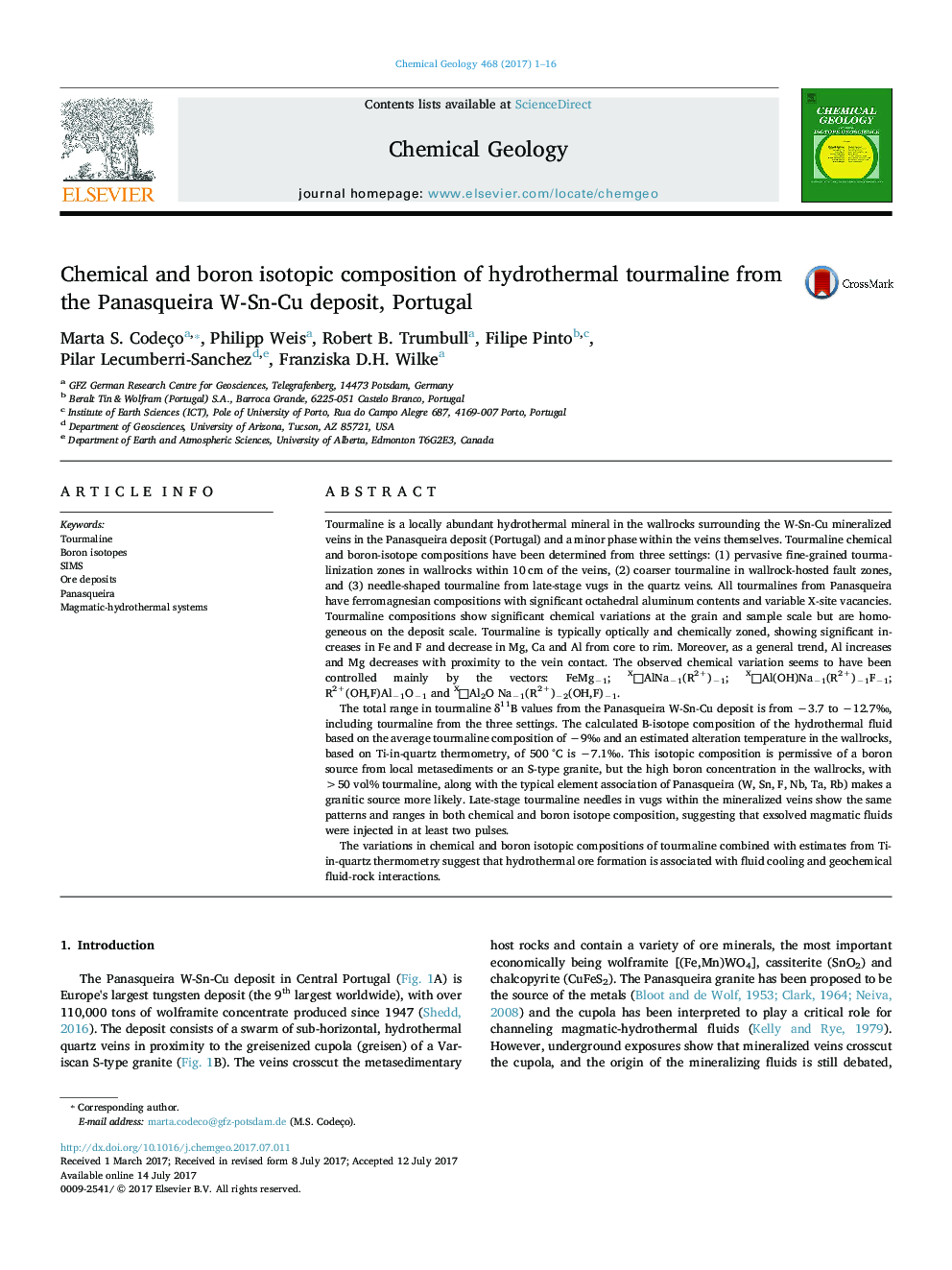| کد مقاله | کد نشریه | سال انتشار | مقاله انگلیسی | نسخه تمام متن |
|---|---|---|---|---|
| 5782711 | 1637506 | 2017 | 16 صفحه PDF | دانلود رایگان |

- Chemical and boron isotopic compositions of tourmaline and Ti-in-quartz temperatures at Panasqueira W-Sn-Cu deposit.
- Compositional variations indicate fluid cooling and fluid-rock interaction as key processes related to ore formation.
- Boron isotopic data are compatible with a single fluid source related to the adjacent S-type granite.
- Compositional trends suggest multiple pulses of magmatic fluids.
Tourmaline is a locally abundant hydrothermal mineral in the wallrocks surrounding the W-Sn-Cu mineralized veins in the Panasqueira deposit (Portugal) and a minor phase within the veins themselves. Tourmaline chemical and boron-isotope compositions have been determined from three settings: (1) pervasive fine-grained tourmalinization zones in wallrocks within 10 cm of the veins, (2) coarser tourmaline in wallrock-hosted fault zones, and (3) needle-shaped tourmaline from late-stage vugs in the quartz veins. All tourmalines from Panasqueira have ferromagnesian compositions with significant octahedral aluminum contents and variable X-site vacancies. Tourmaline compositions show significant chemical variations at the grain and sample scale but are homogeneous on the deposit scale. Tourmaline is typically optically and chemically zoned, showing significant increases in Fe and F and decrease in Mg, Ca and Al from core to rim. Moreover, as a general trend, Al increases and Mg decreases with proximity to the vein contact. The observed chemical variation seems to have been controlled mainly by the vectors: FeMgâ1; Xâ¡AlNaâ1(R2+)â1; Xâ¡Al(OH)Naâ1(R2+)â1Fâ1; R2+(OH,F)Alâ1Oâ1 and Xâ¡Al2O Naâ1(R2+)â2(OH,F)â1.The total range in tourmaline δ11B values from the Panasqueira W-Sn-Cu deposit is from â3.7 to â12.7â°, including tourmaline from the three settings. The calculated B-isotope composition of the hydrothermal fluid based on the average tourmaline composition of â9â° and an estimated alteration temperature in the wallrocks, based on Ti-in-quartz thermometry, of 500 °C is â7.1â°. This isotopic composition is permissive of a boron source from local metasediments or an S-type granite, but the high boron concentration in the wallrocks, with > 50 vol% tourmaline, along with the typical element association of Panasqueira (W, Sn, F, Nb, Ta, Rb) makes a granitic source more likely. Late-stage tourmaline needles in vugs within the mineralized veins show the same patterns and ranges in both chemical and boron isotope composition, suggesting that exsolved magmatic fluids were injected in at least two pulses.The variations in chemical and boron isotopic compositions of tourmaline combined with estimates from Ti-in-quartz thermometry suggest that hydrothermal ore formation is associated with fluid cooling and geochemical fluid-rock interactions.
Journal: Chemical Geology - Volume 468, 30 September 2017, Pages 1-16